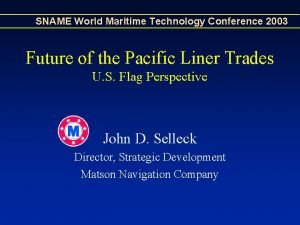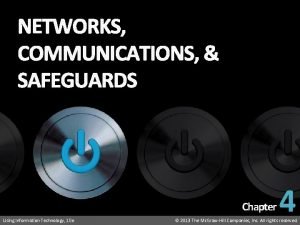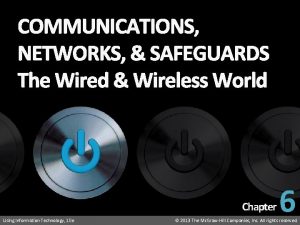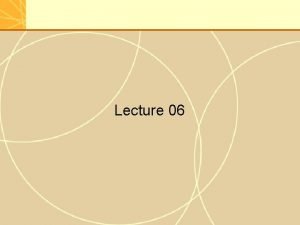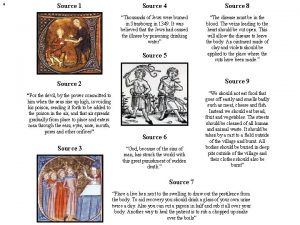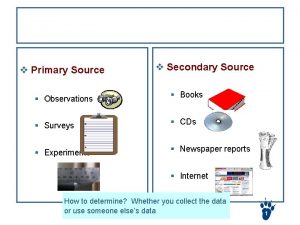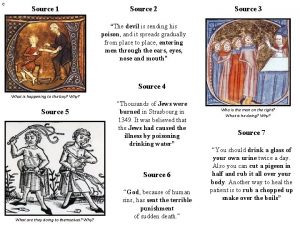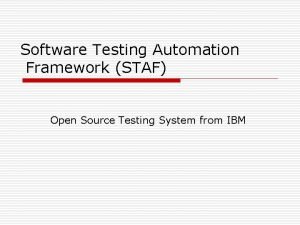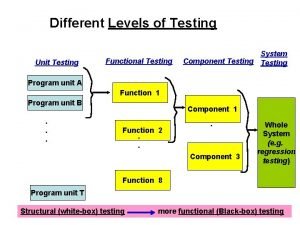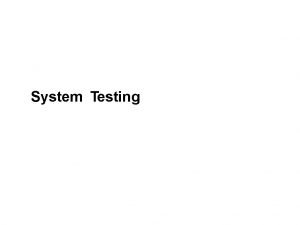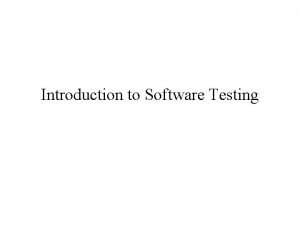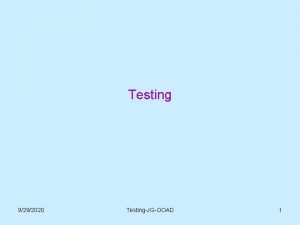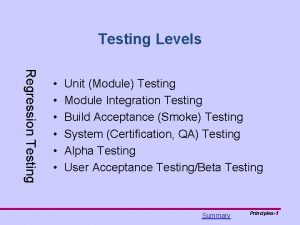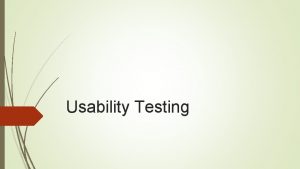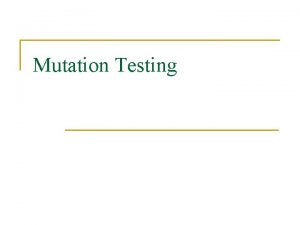World Leader in HV Testing Technology The Source















































































- Slides: 79

World Leader in HV Testing Technology The Source For Field HV Test Equipment Cable Fault Locators w/TDR Oil/Fluid Dielectric Testers Very Low Frequency AC Technology w/TD & PD Diagnostics Portable AC Hipots ------------ DC Hipots & Megohmmeter HV Divider Aerial Lift Testers Higher k. VA AC Sets HVI Products Are Designed to Surpass All Others in Features, Specifications, and Ease in Use 1

MEDIUM & HIGH VOLTAGE CABLE TESTING NEW TECHNOLOGIES BRING NEW METHODS VERY LOW FREQUENCY AC TECHNOLOGY Three new methods of cable testing now available: VLF WITHSTAND – VLF TAN DELTA – VLF PARTIAL DISCHARGE High voltage DC testing of solid dielectric cable insulation is no longer preferred, due to several problems associated with it. High voltage AC testing using VLF is now in. Let’s take a look at the DC issues, VLF technology, the switch to VLF, and the present methods used for testing medium & high voltage cable. mtp 4/19/11

DO YOU ADEQUATELY TEST YOUR CABLES? MOST DON’T. WHY NOT? Q: Transformers - Would you perform no tests on your new or old transformers? A: Of course not, you do many to learn all you can: Hipot, IR, TTR, Doble, Oil Analysis, FRA, and more. Q: Why don’t cables get the same respect? At least the critical ones and those just installed or repaired?

ALL CABLE SYSTEMS DETERIORATE TIME FRAME UNPREDICTABLE Causes of degradation are thermal, mechanical, chemical, atmospheric, corrosion, physical damage, over voltage transient stresses, etc. Even new cable ≠ good cable. Even if no insulation defects exist, what about faulty workmanship on splices, terminations, joints, etc?

DO SOMETHING. THERE ARE NOW SEVERAL MEANINGFUL TESTS AVAILABLE Several well proven and worthwhile field tests are now available for MV & HV cable. Some are inexpensive and easy and some are expensive and complicated. Different data is gained by different tests. You decide what data you need and what action you’re prepared to take.

THIS CAN BE PREVENTED In-service failures cause great damage to faulted cables and adjacent cables. Not so if failed under a VLF test. 10/25/2021 6

SUBJECTS COVERED Cables Need To Be Tested Why DC Is Not Preferred What Is VLF History of VLF Withstand Testing VLF Applications IEEE Standards Vendor Design Differences How To Perform VLF Test VLF For Diagnostic Testing VLF Tan Delta Testing VLF Partial Discharge Testing Selecting A Cable Test Method Selecting a VLF Model Sizes and Vendors Who Uses VLF Conclusion 10/25/2021 7

DC USED FOR DECADES TO TEST CABLE FIRST PILC THEN SOLID DIELECTRIC IT WORKED WELL FOR PILC CABLES, SHOULD WORK FOR SOLIDS, RIGHT? Wrong: 15 – 20 years after solid dielectric cable was installed, it started to fail prematurely. Testing, research, and field experience has shown that solid dielectric cable is prone to develop water trees and DC testing at high voltages creates “trapped space charges” within these trees that leads to failure. Also, leakage currents have been shown to mean little, especially in accessories. Let’s find something better. Q: Can’t there be a good AC method for field hipoting cables, like in the factory? A: Yes - enter VLF. Traditional 50/60 Hz AC power supplies are too big, too heavy, and too expensive, and not portable to test cable in the field. To solve the problem, work on commercial VLF began in the 80’s and the use of VLF is now widespread and from many vendors. It is now well established worldwide.

WHY IS DC HARMFUL? WATER TREES ARE CHARGED BY DC – Tree shaped channels are found within the insulation of operating cables resulting from the presence of defects & moisture in electrical fields. – Prevalent in solid dielectric cables. – Eventually leads to PD and the creation of electrical trees. – Leads to insulation failure. – DC testing hastens failures. 10/25/2021 9

CREATING TRAPPED SPACE CHARGES IN INSULATION Water Trees The 4 – 5 Uo negative output of a DC hipot test polarizes water tree areas. Unlike oil insulated cable, in solid dielectric insulation like XLPE, these “trapped space charges” remain in place after the test. When AC is reapplied, a high difference of potential exists across the remaining insulation. Leads to electrical trees, PD, & cable failure 10/25/2021 10

WHAT WE NOW KNOW ABOUT DC PILC & new EPR, XLPE, etc. - DC OK – no space charges “Service Aged” solid dielectric cable – No DC Why? Again, “Space Charges” trapped in isolated areas of cable cause high stress points leading to failure. Also, current readings taken by DC proven to be not meaningful IEEE and most world engineering bodies agree on issue, as well as cable manufactures and cable research labs DC not compatible with Tan Delta and PD diagnostics A change was needed

THE IDEA OF VERY LOW FREQUENCY OUPUT VOLTAGE HIPOTS WAS BORN We need AC, not DC. Can’t there be a way to test cables in the field with ac voltage instead of dc without needing a 20, 000 lb million $ series resonant transformer? Yes, a Very Low Frequency hipot. Basic physics: lower the frequency of the applied voltage to a cable to lower the charging current. Work began to produce commercially attractive VLF high voltage generators.

VERY LOW FREQUENCY AC HIPOT A VLF HIPOT IS SIMPLY AN AC HIGH VOLTAGE INSTRUMENT BUT WITH A FREQUENCY OUTPUT OF 0. 1 Hz AND LOWER. THE LOWER THE FREQUENCY, THE LOWER THE CURRENT AND POWER REQUIRED TO TEST HIGH CAPACITANCE LOADS LIKE CABLES AND ROTATING MACHINERY. DON’T OVERCOMPLICATE IT. IT’S A SIMPLE AC WITHSTAND TEST. VLF IS THE EASIEST, LEAST EXPENSIVE, MOST CERTAIN WAY OF TESTING THE AC INTEGRITY OF A CABLE. 10/25/2021 13

DROP THE FREQUENCY TO DROP THE POWER NEEDED Very Low Frequency: 0. 1 Hz and lower. By decreasing the frequency, it is possible to test miles of cable with a small and affordable unit. Output frequencies range from 0. 1 – 0. 01 Hz. IEEE 400. 2 recognizes frequencies as low as 0. 01 Hz. At 0. 1 Hz, it takes 600 times less power to test a cable than at 60 Hz, or any other high capacitance load. At 0. 01 Hz, 6000 times higher capacitive loads can be tested than at 60 Hz with the same power consumption. Basic physics, nothing mysterious. 10/25/2021 14

0. 1 Hz vs. 60 Hz Waveform To charge the cable in only 4. 2 ms, it takes 600 x more current than it takes at 2. 5 seconds. 0. 1 Hz = 5 sec. 60 Hz = 4. 2 ms 0. 1 Hz = 10 sec. period 60 Hz = 17 msec. period 600 x diff. At 0. 1 Hz the charging time to max. voltage is 2. 5 seconds. At 60 Hz the charging time to max. voltage is only. 0042 seconds.

VLF EXPLAINED – CALCULATING Xc (the equivalent resistance of a capacitor under AC voltage) Xc = 1 2 x pi x f x C The lower the frequency, the higher the capacitive reactance, or Xc. The higher Xc , or resistance across the power supply output, the lower the current and power needed to apply a voltage. Lower frequency = higher resistance = less current 10/25/2021 16

WHAT A DIFFERENCE THE FREQ. MAKES At 60 Hz. a 1 μF cable has an Xc of 2. 65 k. Ohms. At 22 k. V peak, it requires 8. 3 amps of current to test. Total power supply rating must be 183 k. VA. At 0. 1 Hz, the Xc is 1. 59 megohms. At 22 k. V, the current needed is 14 m. A. Total power supply needed is only. 304 k. VA. (22 k. V is the typical test voltage for 15 k. V cable) 10/25/2021 17

HIPOT COMPARISON OF 60 Hz vs. 0. 1 Hz 60 Hz Hipot 0. 1 Hz VLF 72 lbs 75 lbs 0 - 50 k. Vac @ 3 k. VA Can test ~ 50’ of cable 0 - 28 k. Vac peak, . 4 u. F load @ 0. 1 Hz Can test ~4000’ of 15 k. V cable Great for switchgear testing No good for cables Ideal for cables per IEEE 400. 2 and motors/generators per IEEE 433. 18

WHY TEST CABLES WITH AC VOLTAGE? Cables are designed to carry AC voltage. They are factory tested with AC voltage. Cables operate under AC voltage stress. Cables should be tested with AC voltage. Why would you not use AC if you could? Withstand or Diagnostic – choose what’s best. 10/25/2021 19

VLF FOR CABLE TESTING - REVIEW • Original cables were PILC - many oil filled - DC worked well • Solid Dielectrics introduced in ’ 60’s. DC use just continued • Forty year insulation failing after 15 – 20 years. Why? • Water trees charged up by DC test, programming cable for future failure & DC leakage currents are not very meaningful • We want to test cables in the field with AC, just like in the factory • VLF permits us to AC field test cables with ease for the first time. Also makes AC diagnostic testing possible: TD & PD • 0. 1 Hz allows testing of miles of cable with portable unit • Distribution systems reliability improving with VLF use

THE EARLY DAYS OF VLF It was first used to test large rotating machinery: generators and motors. It was first made and used by GE in the late 50’s early 60’s. ASEA also used VLF around that time. This practice did not continue however with the development of the series resonant system used to test high capacitance loads at power frequency. Also, as with most electrical equipment, it is best to factory test at power frequency. After installation, VLF is ok for field testing. IEEE 433 -1974 (note the standard’s year. VLF is not new) permits VLF testing of generators and motors. The spec calls for 15% more VLF voltage than 60 Hz. It is ideal for rewind shops and field testing.

RECENT VLF HISTORY Once VLF was established as a viable way of testing cables, several companies began work on development. The first to produce a commercially available VLF system was Hagenuk from Germany, now known as Seba Dynatronic. They produced a 54 k. V peak/rms system in ~1985. Since this model was rather large, heavy and not portable, it was/is van mounted. Seba has since developed many models, including portable designs. In 12/96 and 5/97 the two German standards for VLF testing oil insulated cable, DIN VDE 0276 -620, and PVC cable, DIN VDE 0276 -621, were released. These standards disallowed DC on PVC cable. Following Seba was Baur of Austria, who developed their 56 k. V peak model ~1988. It too was rather large and heavy, necessitating a van installation. Both were expensive and caused hesitation in switching from DC testing. Also, DC was not out of favor then to the extent it was ten years later. Both developed good products but were a little premature for the market. They are both now successful in selling VLF as well as diagnostic test methods.

RECENT VLF HISTORY cont. In the mid ’ 90 s, High Voltage, Inc. from NY developed its line of VLF products, the first being a 40 k. V peak model rated for 1. 1 u. F @ 40 k. V @ 0. 1 Hz, released in 1998. This model was two pieces with one weighing 72 lbs and the other 50 lbs: the first truly portable system. It was also relatively inexpensive. With this development, and the models that followed, users had a portable and affordable VLF use was off and running. Shortly after, the IEEE took up writing a standard for VLF testing: IEEE 400. 2 -2004. A revised edition is to be soon released. Recently, other vendors have come about, like HV Diagnostics from Switzerland, offering a 30, 60, and 90 k. V model. From all, over the past 15 years, probably 2000 units have been shipped worldwide. (HVI has shipped ~1000 units to ~ 70 countries).

WHERE IS VLF USED TODAY? Medium and high voltage cable testing is probably 90% of the application for VLF, followed by motor/generator testing. Long cables with high capacitance need the VLF to test them. It is used by hundreds of utilities, testing contractors, & large industrials. VLF satisfies the need for proof testing newly installed, newly repaired, & any critical application cables. It’s also a great splice checker. Small 30 k. V models are used to check the integrity of 15 k. V cables up to 200 k. V models to test HV cables. VLF generators are also used to provide the variable voltage needed for off-line diagnostic testing, like Tan Delta and Partial Discharge. Users have many choices from 4 - 5 vendors, and all the major rental houses in the country carry many models. There is no reason to not use VLF technology. Withstand & Diagnostic Testing Possible

MEDIUM & HIGH VOLTAGE CABLE TESTING WHY YOU SHOULD BE TESTING WITH VERY LOW FREQUENCY AC TECHNOLOGY THREE METHODS OF CABLE TESTING NOW AVAILABLE VLF WITHSTAND – VLF TAN DELTA – VLF PARTIAL DISCHARGE DC voltage testing of solid dielectric cable insulation is on it’s way out. It already is in much of the world. VLF AC testing is the preferred method. Let’s take a look at VLF and the present methods used for testing medium & high voltage cable.

VLF AC CABLE TESTING TECHNOLOGY WITHSTAND & DIAGNOSTIC APPLICATIONS There are three commonly used methods for field testing medium and high voltage cable using VLF technology. We’ll take them one at a time, although often all three are used on the same cable. Ø VLF Withstand Proof/hipot testing Ø VLF – TD Tan Delta Diagnostic testing Ø VLF – PD Partial Discharge Diagnostic testing

DEFINING THE WITHSTAND TEST Apply the overvoltage – pass or fail We have used AC withstand testing for decades to test most types of substation apparatus. Is the item good or bad, does it hold the necessary AC voltage or not? DC is not used, shouldn’t be used, to “interpret” whether the load is good or bad? The vacuum bottle, rubber glove, hot stick, bus work, insulator, etc. either holds voltage or doesn’t, there is no in-between. Now do the same with cable. The most basic VLF test is a withstand, or proof, test. Apply the voltage for some length of time. The cable either holds the voltage or fails. If there are severe defects that initiate partial discharge, the test forces their growth to failure. If it fails, repair or replace and retest. Minor defects unaffected by the test voltage remain as is. If it passes, the cable is assumed to be good for at least another ~5 years. If it fails again, further thought must be given to decide future steps.

PREMISE BEHIND VLF TESTING The VLF voltage stress is applied to the cable. Defects severe enough to be triggered into partial discharge, creating an electrical tree, are allowed to grow to failure. (VLF rapidly grows electrical trees to failure. ) Defects small enough to not be triggered into pd are not affected, or aggravated. Good insulation is not affected. (It’s factory tested at voltages far higher. ) If a VLF test is performed properly - proper voltage level and time duration - the user can be well assured of no in-service failure for years. If a cable can hold 2 – 3 x operating voltage, it’s good.

CABLE APPLICATONS FOR VLF There are several obvious and common sense reasons to use VLF. 1. Test after installation. The cable is already de-energized. Guarantee no damage occurred during installation and prove the workmanship on accessories is good. Most faults are in terminations, splices, etc. 2. Test after repair. Initial fault may have damaged more cable. Over voltage thumping may have created more faults. Avoid the need for another repair in two months. Often rapid repairs not done properly. VLF after repair to perform a quick check of cable to verify safe to reenergize. Not a full VLF test but a better check than other methods. 3. Test critical cables on a regular basis. Cause failure when convenient and not during service. VLF failure causes very little damage to cable. 4. VLF is also used to provide the voltage for diagnostic testing, like Tan Delta and Partial Discharge. (More on that later. )

OTHER METHODS DON’T GET IT DONE CABLE NOT EVEN STRESSED ABOVE OPERATING VOLTAGE DC Hipot 5 k. Vdc “Megger” DC Hot stick adaptor 24 hour soak VLF It! 10/25/2021 An overvoltage AC withstand test is the most certain method of testing a cable. 30

IEEE 400. 2 -2004 STANDARD (STANDARD NOW UNDER REVIEW AND WILL BE REISSUED SOON. ) The IEEE 400. 2 VLF test standard defines the required test voltages. The time duration for the test is suggested to be 30+ minutes, which has shown to eliminate up to 95% of defects. A 60 minute test may be performed to be nearly 100% assured that no defects nearing failure remain. The voltages specified are generally 2 – 3 times the normal operating voltage. The actual values are determined by the insulation thickness and the desired k. V/mm of test voltage stress. Note: Perform the test properly or do not test at all. Suggested time and voltage are necessary to allow electrical trees started to grow to failure. An abbreviated test or too low a voltage test may only aggravate defects and lead to future in-service failures. Like with most tests, let the technology work.

IEEE 400. 2 FIELD TEST VOLTAGES For Shielded Power Cable Systems Using Sine Wave Output VLF ----------- 0. 1 Hz Test Voltage ----------System Voltage phase to phase Installation Acceptance Maintenance phase to ground k. Vrms/k. Vpeak 5 9/12 10/14 7/10 15 18/25 20/28 16/22 25 27/38 31/44 23/33 35 39/55 44/62 33/47 46 * 51/72 57/81 43/61 69 * 75/106 85/119 63/89 Test voltages are generally 1. 5 – 3 time the line-to-ground system voltage. 10/25/2021 * Proposed for next version of standard, now under review. 32

OTHER VLF STANDARDS • IEEE 400 -2001 Cable testing standard approving VLF for use. • IEEE 400. 2 -2004 • IEEE 433 -2009 Standard specific for VLF and Tan Delta methods of cable testing. Currently being updated. Partial discharge testing of shielded power cable Systems in a field environment. Permits VLF Defines VLF for testing rotating machinery. • VDE 0267 -620/621 German standards for VLF cable testing • IEEE 400. 3 -2006 • IEC 60060 -3 • Cenelec H 620 Standard for field testing power cable, including VLF Harmonized European Standard Other world standards under way in several countries

VLF WITHSTAND TEST PROCEDURE Ø VLF testing is easier than DC testing. Ø No leakage current measurements taken. Only current is charging current each half cycle, shown on VLF current meter. No resistive leakage current. Ø Remove all arrestors, capacitors, transformers, etc. Ø Isolate cable ends like with DC testing, although less cleaning, bagging, installing corona rings, etc is necessary. Ø Connect VLF HV lead to conductor & ground to shield. Ø After selecting appropriate test frequency, depending on length, apply voltage. Ø There are no leakage currents to read. Test is go/no-go Ø If cable holds, test is over. Cable is good for years. Ø If cable fails, make repairs and repeat test, or replace. Ø If second insulation failure occurs, maybe stop testing and replace cable or select another testing method. If splice fails, repair and retest. Ø 10/25/2021 Most models can test all three phases at once, saving time. 34

VLF TEST HOOKUP PER IEEE 400. 2 Some VLF units have no return wire. HV output and ground cables only. 10/25/2021 35

VLF-4022 CM 10/25/2021 36

OPERATING INSTRUCTIONS 1. Select Frequency 3. Rotate to zero (Zero start intl’k) 6. Rotate to raise voltage 5. Press HV On 4. Press Main Power 2. Turn to m. A This model is an electro-mechanical design, similar to most hipots, from HVI. Others 37 from HVI and other vendors are electronic in design and microprocessor operated.

WHAT IS CABLE FAILURE INDICATION? HVI Model Thermal overload on panel will trip Voltmeter will indicate breakdown Current will spike 10/25/2021 38

FAULT LOCATING NECESSARY When VLF testing, cable failures will occur. Someone has to find them. Thumpers, or VLF thumpers must be available. 10/25/2021 39

VLF CABLE DIAGNOSTIC TESTING A non-destructive method of learning of the quality of the insulation, helping to prioritize cable repair, replacement, injection or additional testing. There are times when a VLF test is not appropriate. A nondestructive diagnostic test is preferred. A diagnostic test will show you the quality of the insulation and/or locations of defects without the risk of failure. Although both can be performed using power frequency supplies, there are several advantages to using VLF AC generators for field testing, like size, weight, cost, power consumption, etc. VLF-TD: Tan Delta Testing - Global Assessment 10/25/2021 VLF-PD: Partial Discharge Testing - Defect Location 40

OTHER USES FOR VLF - DIAGNOSTICS Diagnostic Testing: Tan Delta & Partial Discharge. Performed off-line with elevated voltages: a VLF is used as the voltage supply, usually at 0. 1 Hz. Tan Delta tests the overall quality of the cable. Measures the total deterioration of the cable length; grade cables and compare to help prioritize replacement or injection or to determine other tests that may be useful. Relatively inexpensive, easily performed, and now common. Partial Discharge testing hopes to locate specific sites of pd and their severity. Measures inception voltage and extinction voltage to better determine the nature of the defect. Good way to inspect accessories. Most expensive and complicated method and just now being used for field PD testing with VLF. Interpretive analysis can be problematic. VLF Withstand – VLF TD – VLF PD Supplying nearly all the data possible about a cable’s condition.

VLF AC CABLE TESTING TECHNOLOGY WITHSTAND & DIAGNOSTIC APPLICATIONS There are three commonly used methods of field testing medium and high voltage cable using VLF technology. We’ll take them one at a time, although often all three are used on the same cable. Ø VLF Withstand Proof/hipot testing Ø VLF – TD Tan Delta Diagnostic testing Ø VLF – PD Partial Discharge Diagnostic testing

VLF – TD DIAGNOSTIC CABLE TESTING VLF TANGENT DELTA (TAN δ) MEASUREMENT Also called Dissipation Factor or Loss Angle Over time, cable insulation degrades due to thermal, chemical, mechanical, and atmospheric conditions, as well as physical damage during installation. Accessories degrade for the same reasons and often from improper workmanship. TD testing is a non-destructive method to determine the extent of insulation and accessory degradation over the entire cable length measured. Find out which of your cables are Highly Degraded, Slightly Degraded, or Good? 10/25/2021 43

SIMPLIFIED CABLE MODEL AND PHASOR Tan Delta = IR/IC = 1/(2 f. CR) Pure C angle = 0 Pure R angle = 90° A deteriorated cable may show an angle of 0. 5° - 1° (0. 0175 radians) In a perfect cable, characteristics are similar to a capacitor. Current Ic is 90° phase shifted from voltage V, making the angle δ = 0°. The more deteriorated the insulation is, the more the angle δ grows, to maybe 0. 5°. The greater the angle, the more resistive the cable appears, or the more deteriorated the cable’s insulation and accessories are. Test many cables, grade and compare them to replace and/or inject the weakest first. 44

TAN DELTA (δ) MEASUREMENT Using VLF @ 0. 1 Hz • Excellent predictive tool for determining the integrity of cable • Absolute values, variations, and trending of values are of interest for predicting insulation and accessory integrity • Evaluates over all condition of cable (rather than local as with PD measurement) • Tan Delta is more easily measured at VLF (magnitude increases as frequency decreases) • Requires VLF sinusoidal applied test voltage • Excellent method to evaluate Water Trees • Easy to use and interpret measurements • Comparative test to prioritize cable replacement, injection, or to determine what other tests may be useful 45

WATER TREES ADD RESISTIVE ELEMENT Cable is no longer purely capacitive Delta angle becomes >0° • TD can measure the extent of water tree damage • Tree shaped channels are found within the insulation of operating cables resulting from the presence of moisture in voids within an electrical field • Most prevalent in aged XLPE and PE cables • Water tress eventually grow to become electrical trees and emit partial discharge • PD activity leads to in-service failures 46

CHARACTERISTICS OF WATER TREES Typical Water Tree in XLPE Addition of a new parallel R- C component The R component is Voltage Dependent (non – linear) Tan Delta numbers trend upward with increasing voltage 47

Typical TD graph TD # vs. rising test voltage Test stopped to prevent cable failure. Phase C is "Highly Degraded". C B A Phases A & B - "good" with little rise in TD numbers with increasing voltage. TD numbers in the 8 – 10 x 10 -3 range are typical for new EPR. .

TAN DELTA MEASUREMENT DEVICES Devices available up to 200 k. V peak Tan Delta & Partial Discharge 70 k. V model 60 k. V model HV divider Signal analyzer M & B Systems - England 10/25/2021 Power Diagnostix – Germany 49

TAN DELTA HOOKUP USING HVI VLF Not all models

TAN DELTA TESTING Advantages • Less destructive than VLF or 60 Hz testing • Measures overall condition of cable and accessories • Aids in prioritization of cable replacement/repair • Test easily performed and interpreted Disadvantages • Can be destructive if test voltage is too high • Gives overall condition of cable, not singularities • Not best for mixed type cable runs • More useful with historical data Conclusion TD testing is an easy method to evaluate many cables for comparison to help determine where replacement or injection efforts are best spent. It also helps to determine what other tests may be useful. 10/25/2021 51

VLF AC CABLE TESTING TECHNOLOGY WITHSTAND & DIAGNOSTIC APPLICATIONS There are three commonly used methods of field testing medium and high voltage cable using VLF technology. We’ll take them one at a time, although often all three are used on the same cable. Ø VLF Withstand Proof/hipot testing Ø VLF – TD Tan Delta Diagnostic testing Ø VLF – PD Partial Discharge Diagnostic testing

VLF – PD DIAGNOSTIC CABLE TESTING VLF PARTIAL DISCHARGE TESTING Over time, cable insulation degrades due to thermal, chemical, mechanical, and atmospheric conditions, as well as physical damage during installation. Accessories degrade for the same reasons and often from improper workmanship. PD testing is a non-destructive method to determine the locations and severity of electrical discharges (PD) within your cable system. Where are the bad spots? Don’t you want to know where and how severely your cable is degraded, and without risking failure during the test?

OFF-LINE PARTIAL DISCHARGE TESTING Off-Line PD testing is a method of evaluating a cable’s insulation and accessories to locate and measure the severity of defects. If performed properly, it is a non-destructive test. PD testing is a critical test performed in the factory using power frequency equipment. Now, portable and readily available VLF products bring PD testing to the field, and with equipment within the economic reach and ease in use for most to purchase and perform their own testing. 10/25/2021 54

OFF-LINE PARTIAL DISCHARGE TESTING Pd testing locates areas of pd and their magnitude. We measure the pd inception voltage, or PDIV (at what voltage does it start) and the pd extinction voltage, PDEV (at what voltage does it extinguish). With this known, an educated decision can be made as to the action required. Some levels of pd are acceptable while others are not. Generally, any pd in the insulation is not acceptable, however, splices and terminations can live for years with high pd. For example, pd that starts in the insulation at 1. 7 – 1. 8 Uo is usually acceptable. If it starts at only 1. 1 – 1. 5 Uo, it is worrisome and some action may be required. Performed properly with the right equipment and interpretation, locations of pd can be accurately measured and evaluated.

TYPICAL TD/PD SCREEN SHOT Shows PD magnitude and location – From Power Diagnostix Systems GMBH Takes some training and data interpretation

SAMPLE TD/PD SCREEN SHOT Another screen shot

VLF AC CABLE TESTING TECHNOLOGY WITHSTAND & DIAGNOSTIC APPLICATIONS We have described the three commonly used methods for field testing cable using VLF technology. Which ones are right for your application depend on many variables. Not all will be practical or even prudent for your situation. Know the differences in results, availability, ease of use, and cost. Ø VLF Withstand Proof/hipot testing Ø VLF – TD Tan Delta testing Ø VLF – PD Partial Discharge testing

SEVERAL METHODS – WHAT TO USE? VLF Withstand - VLF Tan Delta - VLF Partial Discharge Ideally, all should be used to gain all the data possible. However, there are real world factors affecting the decision. 1. 2. 3. Type of test results desired Ease of use and interpretation Cost & availability of equipment There is no single method that does it all. A variety of approaches are needed to learn as much as possible. What test data do you want and what are you going to do with it? 10/25/2021 59

SELECTING A CABLE TEST METHOD Common methods include: • • • AC Power Frequency AC Series & Parallel Resonant DC Hipot Dielectric Test Very Low Frequency (VLF) AC Hipot Tan Delta, Partial Discharge, and Other Diagnostic Methods – Power Frequency or VLF Selection often depends on the information desired and the options available for repair and/or replacement 10/25/2021 60

DEFINE THE GOALS OF YOUR TESTING Which tests are best & what will you do with the data? Verify new installation – fail, find, and fix? Verify repaired cable before re-energizing? Verify critical cables during downtime? Compare many cables to prioritize replacement or injection and/or to determine if other tests are needed? • Is cable direct buried requiring exact fault location, or is it in conduit and easily replaceable? • Cost of equipment, availability, ease in use, ease in analysis, etc. . all must be weighed against the usefulness of the data gathered. • • Match the test methods to your situation 10/25/2021 61

WHAT’S THE INSTALLATION SITUATION? • • Direct buried – must pinpoint problem to repair Cable in conduit or trench - replaceable Cable in raceways – visible and easily replaceable How old is cable What is the failure history How easy is it to repair Is there alternate feed should failure occur during test Is fault location and repair available • How much downtime can be tolerated 10/25/2021 62

EXAMPLES OF SITUATION vs. METHOD New Install: Diagnostic test not needed, the insulation is good. VLF it to make sure there is no installation damage, bad splice work, etc. Old suspect cable: There may be many defects, don’t VLF. Use TD to see how degraded cables are to prioritize replacement. If modest degradation, then VLF, maybe some are still good. Critical cable in conduit: VLF it. If it fails, replace it. Direct buried, hard to repair: TD test to evaluate condition to prioritize cable injection or replacement. Could PD and then use VLF to expose defects if just a few. Prioritization for replacement or injection: If a comparative condition assessment test is desired, tan delta is the easiest method. Post repair test: VLF repaired cable to make sure it holds and there is no further damage caused by over voltage thumping. 10/25/2021 63

SO, WHAT TO DO? NO SHORT AND EASY ANSWER Depends on money, time, ability to interpret diagnostic techniques, access to site, time allowed for test, available people, action possible for repair or replace, and many other factors. A combination of methods is needed: some easy and economical (VLF) and some more complicated and more expensive (TD & PD), and each yielding different but important data about your cable. 10/25/2021 64

IT ALL STARTS WITH A VLF HIPOT VLF Withstand testing and VLF Tan Delta testing have been widely accepted and used for over 15 years. VLF Partial Discharge testing is now becoming common. VLF testing of some type is in your future. As more industrial customers, utilities, specifying engineers, and others specify VLF testing, you will need a VLF. In addition to performing VLF AC stress tests, a VLF hipot is the voltage source for other tests, like partial discharge and tan delta. At the very least, a VLF should be available to verify new installation work, repairs, and/or critical cables that cannot fail in service. Whatever the frequency - 50 Hz, 60 Hz, 0. 1 Hz, 0. 05 Hz – all are effective to perform AC withstand testing and as a voltage source for TD & PD testing. VLF technology makes is affordable and portable. 10/25/2021 65

SELECTING A VLF MODEL Specs to know before model selection Must know the cable voltage and test specs to select voltage. Ex: the Maintenance test on a 15 k. V cable is 22 k. V peak. Must know the cable load capacitance: the u. F rating. Typical VLF Output Spec Must know the required frequency of test. Output Volt: 0 - 60 k. Vac Peak Will it be used to Tan Delta and Partial Discharge testing? Output Load: 0. 10 Hz 0. 05 Hz 0. 02 Hz 0. 01 Hz VLF ratings and selection VLFs are sized from 20 k. V – 200 k. V. Peak and rms specs. Models are rated by the u. F of load they can test. Ratings from 0. 4 – 50 u. F. Most are variable frequency of 0. 1 – 0. 01 Hz: does spec allow frequencies below 0. 1 Hz for withstand testing? For TD & PD testing, 0. 1 Hz is used. Get a VLF rated at 0. 1 Hz for the u. F rating needed. Lower frequencies permit higher u. F testing. 0. 05 Hz can test twice 0. 1 Hz. IEEE 400. 2 allows the use of 0. 1 Hz – 0. 01 Hz, so should testing specifications. @ 1. 1 μF @ 2. 2 μF @ 5. 5 μF @ 11. 0 μF

VLF MODEL SIZES AVAILABLE There are many models from the 4 or 5 major vendors. Models are designed for a voltage output and a capacitance (u. F) load rating at several specific frequencies from 0. 1 Hz – 0. 01 Hz. Voltage ratings range from 20 k. Vac – 200 k. Vac with capacitive load ratings from 0. 4 u. F – 50 u. F Example: For a 15 k. V cable test of 22 k. Vac peak l-g, a 0. 1 Hz @ 0. 5 u. F VLF can test up to 4000’ depending on cable diameter. Lengths up to 30 miles can be tested by some VLF units. 10/25/2021 67

VENDOR DESIGN DIFFERENCES WAVEFORM OUTPUT Of the four major VLF vendors, two output waveforms are offered: sine wave & cosine-rectangular (trapezoidal). Both work well to VLF withstand test cable. - However A sine wave VLF is better suited for use as a voltage source for tan delta and partial discharge testing, both desirable add-ons to VLF testing. Also, a sine wave is necessary for motor/generator testing per IEEE 433.

Waveform Outputs High Voltage, Inc. - USA Sine Wave Baur - Austria Sine Wave Seba (HDW) – Germany Cosine-Rectangular HVDSA - Switzerland Sine Wave * Sine wave needed for PD and TD diagnostics 10/25/2021 69

VLF OUTPUT VOLTAGE – PEAK vs. RMS WHY DO WE READ PEAK VOLTAGE Originally and still, VLF units were metered in peak voltage output for two reasons. The first reason is that one of the original VLF products produced offered a nearly rectangular waveform output (called a cosine-rectangular waveform), so the peak and rms were the same, so there was no issue. Now there are many sine wave producing VLF models so it is an issue and must be noted when specifying test voltages. IEEE 400. 2 includes both peak and rms values. Secondly, using peak recognized that it is the peak of the waveform, not the rms, that initiates partial discharge, the central element in causing defects to grow and fail under the test voltage. The maximum, or peak, voltage is what is important in this case.

VLF MODELS FROM VARIOUS VENDORS – MANY MODELS NOT SHOWN High Voltage, Inc. - NY 28 k. V Baur - Austria Seba – Germany 60 k. V 34 k. V HV Diagnostics Switzerland 28 k. V 30 k. V 34 k. V 90 k. V 200 k. V 60 k. V 56 k. V W/PD & TD 60 k. V 54 k. V 60 k. V Voltages are in peak. Load ratings from 0. 4 u. F – 50 u. F

WHO USES VLF? UTILITIES TESTING SERVICES INDUSTRIALS CONTRACTORS Other methods of cable testing have their place, but VLF is embraced worldwide as the easiest, most effective, most economical method of cable testing. Over 1000 VLF units have been shipped from High Voltage, Inc. over the last 12 years, delivered to 70+ countries and many US locations. Other VLF products have shipped from other vendors for even longer.

COUNTRIES USING HVI VLF HVI has shipped > 1000 VLF products to > 70 countries partial list USA Canada Taiwan Indonesia So. Korea Australia Saudi Arabia England Costa Rica Bolivia Israel 10/25/2021 So. Africa Singapore Hong Kong Belgium Puerto Rico Holland New Zealand Japan Malaysia Russia Spain Slovak Republic Czech Republic China UAE Vietnam Panama Jordan Germany Cyprus Honduras Lithuania Thailand Mexico India Bulgaria Fiji Venezuela Finland Greece Qatar Argentina Italy 73

SUMMARY & CONCLUSION No one test method can do it all. Use one or all three to learn the most about your cables. Not all may be appropriate Before selecting the approach, know what data you need and what you are going to do with it Match the test technology with the desired results, weighed against cost, availability, ease of test, etc. Years of experience, standards, and results verify VLF Now VLF-TD and VLF-PD are available for field testing You test everything else with multiple methods, why not cable

SUMMARY & CONCLUSION VLF Withstand testing is the most effective method of exposing cable and accessory defects. With the Tan Delta and Partial Discharge options, both hipot and diagnostic tests are possible. Suitable for use on cables and rotating machinery. Worldwide standards exist for both. Hundreds of users worldwide have embraced VLF with more joining the ranks every week. VLF It! It’s fast, easy, and sure. 10/25/2021 75

VARIOUS APPLICATION PHOTOS TD Test 15 k. V XLPE VLF TD & PD test 22 k. V cable 200 k. V VLF Trans. Test 200 k. V VLF - VLF TD - VLF PD test truck 120 k. V VLF test truck

WIND FARM 35 k. V CABLES ARE IDEAL FOR VLF WITHSTAND TESTING VLF Acceptance Test per IEEE 400. 2 VLF Hipot testing 3 phases at once @ 62 k. Vac peak for 30 - 60 mins. 0 - 62 k. Vac peak VLF Cable system is new but needs VLF Withstand test to find faulty workmanship on splices and terminations and possible cable installation damage. Tan Delta and Partial Discharge testing are not needed. VLF It!

LEADER IN HV TEST EQUIPMENT & VLF TECHNOLOGY Cable Fault Locators w/TDR Oil/Fluid Dielectric Testers Very Low Frequency AC Technology w/TD & PD Diagnostics Portable AC Hipots ------------ DC Hipots & Megohmmeter HV Divider Aerial Lift Testers Higher k. VA AC Sets 78

THANK YOU Mike Peschel Co-Owner, Chairman, & Executive VP High Voltage, Inc. Copake, NY www. hvinc. com sales@hvinc. com
 Transactional leadership and transformational leadership
Transactional leadership and transformational leadership What is domain
What is domain Kv charts in software testing
Kv charts in software testing Du path testing
Du path testing Positive vs negative testing
Positive vs negative testing Cs3250
Cs3250 Localization globalization testing
Localization globalization testing Functional testing vs unit testing
Functional testing vs unit testing What is testing
What is testing Control structure testing in software engineering
Control structure testing in software engineering Decision table testing in software testing
Decision table testing in software testing Decision table for triangle problem
Decision table for triangle problem Materi black box testing
Materi black box testing Behavior testing adalah
Behavior testing adalah Decision tables testing
Decision tables testing Rigorous testing in software testing
Rigorous testing in software testing Testing blindness in software testing
Testing blindness in software testing Component testing is a black box testing
Component testing is a black box testing Software domain examples
Software domain examples Cutting tools used in workshop
Cutting tools used in workshop Wit source technology
Wit source technology Asterisk open source technology
Asterisk open source technology Hình ảnh bộ gõ cơ thể búng tay
Hình ảnh bộ gõ cơ thể búng tay Frameset trong html5
Frameset trong html5 Bổ thể
Bổ thể Tỉ lệ cơ thể trẻ em
Tỉ lệ cơ thể trẻ em Voi kéo gỗ như thế nào
Voi kéo gỗ như thế nào Tư thế worm breton là gì
Tư thế worm breton là gì Hát lên người ơi
Hát lên người ơi Kể tên các môn thể thao
Kể tên các môn thể thao Thế nào là hệ số cao nhất
Thế nào là hệ số cao nhất Các châu lục và đại dương trên thế giới
Các châu lục và đại dương trên thế giới Cong thức tính động năng
Cong thức tính động năng Trời xanh đây là của chúng ta thể thơ
Trời xanh đây là của chúng ta thể thơ Mật thư tọa độ 5x5
Mật thư tọa độ 5x5 Phép trừ bù
Phép trừ bù Phản ứng thế ankan
Phản ứng thế ankan Các châu lục và đại dương trên thế giới
Các châu lục và đại dương trên thế giới Thể thơ truyền thống
Thể thơ truyền thống Quá trình desamine hóa có thể tạo ra
Quá trình desamine hóa có thể tạo ra Một số thể thơ truyền thống
Một số thể thơ truyền thống Cái miệng bé xinh thế chỉ nói điều hay thôi
Cái miệng bé xinh thế chỉ nói điều hay thôi Vẽ hình chiếu vuông góc của vật thể sau
Vẽ hình chiếu vuông góc của vật thể sau Thế nào là sự mỏi cơ
Thế nào là sự mỏi cơ đặc điểm cơ thể của người tối cổ
đặc điểm cơ thể của người tối cổ V cc
V cc Vẽ hình chiếu đứng bằng cạnh của vật thể
Vẽ hình chiếu đứng bằng cạnh của vật thể Tia chieu sa te
Tia chieu sa te Thẻ vin
Thẻ vin đại từ thay thế
đại từ thay thế điện thế nghỉ
điện thế nghỉ Tư thế ngồi viết
Tư thế ngồi viết Diễn thế sinh thái là
Diễn thế sinh thái là Dạng đột biến một nhiễm là
Dạng đột biến một nhiễm là Số nguyên tố là gì
Số nguyên tố là gì Tư thế ngồi viết
Tư thế ngồi viết Lời thề hippocrates
Lời thề hippocrates Thiếu nhi thế giới liên hoan
Thiếu nhi thế giới liên hoan ưu thế lai là gì
ưu thế lai là gì Hổ đẻ mỗi lứa mấy con
Hổ đẻ mỗi lứa mấy con Sự nuôi và dạy con của hổ
Sự nuôi và dạy con của hổ Sơ đồ cơ thể người
Sơ đồ cơ thể người Từ ngữ thể hiện lòng nhân hậu
Từ ngữ thể hiện lòng nhân hậu Thế nào là mạng điện lắp đặt kiểu nổi
Thế nào là mạng điện lắp đặt kiểu nổi Real world technology solutions
Real world technology solutions World maritime technology conference
World maritime technology conference Sample design and technology gcse examination paper answers
Sample design and technology gcse examination paper answers Introduction to information technology: your digital world
Introduction to information technology: your digital world Introduction to information technology: your digital world
Introduction to information technology: your digital world Opposable thumb primates
Opposable thumb primates New world to old world columbian exchange
New world to old world columbian exchange Real world vs digital world
Real world vs digital world The world of ideas plato
The world of ideas plato Ap world history chapter 25 africa and the atlantic world
Ap world history chapter 25 africa and the atlantic world The changing world output and world trade picture
The changing world output and world trade picture Dangerous world tour setlist
Dangerous world tour setlist An elementary school classroom in a slum theme
An elementary school classroom in a slum theme An elementary school classroom in a slum images
An elementary school classroom in a slum images English 9 unit 9
English 9 unit 9 The changing world output and world trade picture
The changing world output and world trade picture

































































